Wiring diagrams ER AP/APB
ER-AP 60, ER-APB 60
ER-AP 100, ER-APB 100
Standard model

Switching on
The unit starts up after switching on with switch S1 (room lighting).
Switching off
After switching off with switch S1, the unit also switches off.
ER-AP 60 VZ, ER-APB 60 VZ
ER-AP 100 VZ, ER-APB 100 VZ
VZ standard switching
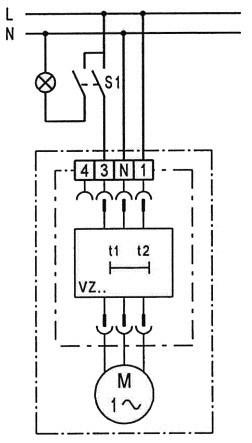
Switching on
The unit starts up approx. 50 seconds after switching on with switch S1 (room lighting).
Switching off
The unit has an overrun time of approximately 6 minutes after switching off with switch S1 and then switches off.
VZ switching variant 1
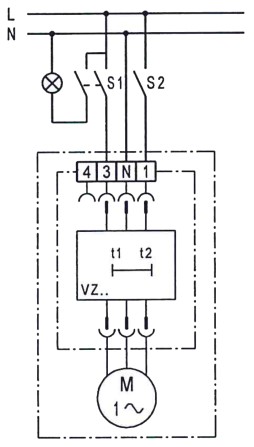
Switching on
The unit starts up approx. 50 seconds after switching on with switch S1 (room lighting) and switch S2.
Switching off, scenario 1
The unit has an overrun time of approximately 6 minutes after switching off with switch S1 (room lighting) and then switches off.
Switching off, scenario 2
The unit is switched off directly with switch S2, i.e. regardless of the room lighting.
ER-AP 60 F, ER-APB 60 F
ER-AP 100 F, ER-APB 100 F
F standard switching:

The F fan is designed for installation in windowless, dark rooms. The unit is switched on wirelessly through the brightness of the room lighting by a light control unit. The unit starts up after approximately 50 seconds.
The minimum switch-on brightness is 30 lx on the front of the cover.
Switching on
The unit starts up approx. 50 seconds after switching on the room lighting with switch S1.
Switching off
The unit has an overrun time of approximately 6 minutes after switching off the room lighting with switch S1 and then switches off. For the unit to switch off, the room must be dark (max. lighting strength at the front of the cover is 0.3 lx).
F switching variant

Switching on
The unit starts up approx. 50 seconds after switching on the room lighting with switch S1. Switch S2 is closed.
Switching off, scenario 1
The unit has an overrun time of approximately 6 minutes after switching off with switch S1 (room lighting) and then switches off.
Switching off, scenario 2
The unit can be switched off directly with switch S2, i.e. regardless of the room lighting.
Function of the H model
Once the fan insert has been installed, the unit regulates to the current room humidity (relative humidity). This humidity value is saved as the first reference value. The reference value does not have to be specified manually.
If the room humidity increases by 7 % within 2 minutes, the fan automatically switches to the nominal load level (60 m³/h or 100 m³/h). The unit continues to run at nominal load level until the stored reference value is undercut again.
If the humidity falls below the saved reference value, the overrun operation starts with an overrun time of 15 minutes (nominal load) If the humidity does not fall below the reference value within 60 minutes, the unit switches back into the operating status before the humidity control was activated. The current humidity value is saved as the new reference value.
If the relative humidity falls below the reference value during operation, the newly established reference value is saved. ER ...H fans can also be operated using the light switch.
With “Light on”, the fan starts in nominal load. Actuation via the light switch takes priority over the automatic humidity function. With “Light off”, the unit continues to run until the remaining overrun time (15 minutes) has passed. The automatic humidity function is then assigned maximum priority again and controls the unit.
ER-AP 60 H, ER-APB 60 H
ER-AP 100 H, ER-APB 100 H
H standard switching
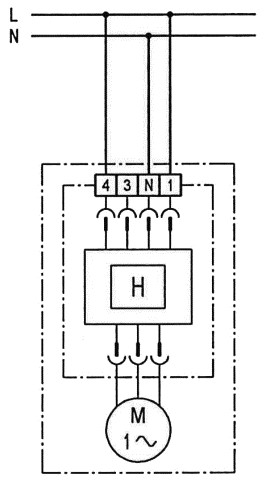
Unit with humidity control.
The switch-on and switch-off point is automatically set (Installation of fan insert and upper part of housing).
Standard switching:
Permanent base load operation
Switching on
The unit is running in base load operation, humidity control is active. If the switch-on point is exceeded, the unit switches automatically over to full load mode.
Switching off
The unit switches automatically back to base load operation if the relative humidity falls below the switch-off point.
H switching variant 1
Permanent base load operation with pre-defined overrun time
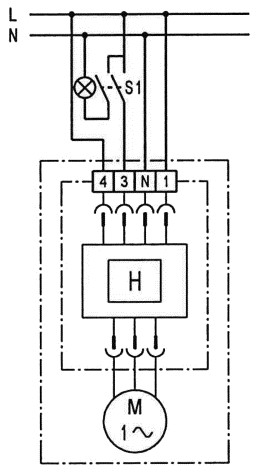
Switching on
The unit is running in base load operation. Humidity control is active, see standard switching. Switch S1 can manually be switched to full load operation.
Switching off
After switching full load operation off with S1, the unit continues in full load operation for an overrun time of 6 minutes. If, after this time, the humidity as measured at the unit:
- is higher than the saved reference value, the fan continues to run in full load operation until the humidity drops below the reference value. After the 15 minutes of overrun time, the fan switches back to base load operation.
- is lower than the saved reference value, the fan automatically switches back to base load operation after an overrun time of 15 minutes.
H switching variant 2
Manual base load operation
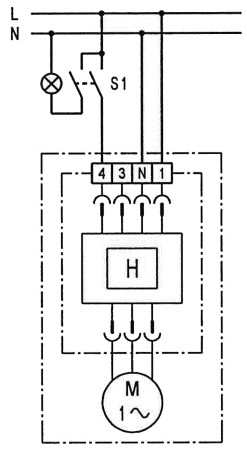
Switching on
The unit is switched manually to base load with switch S1. Humidity control is active, see Standard switching.
Switching off
When manually switching off with switch S1, if the unit is in:
- full load operation, i.e. humidity is present, the unit continues to run until the humidity drops below the saved reference value. After the 15 minutes of overrun time, the fan switches back to base load operation.
- base load operation, the unit switches itself off automatically.
Note: The unit may start up automatically if switch S1 is open.
H switching variant 3
Manual full load operation with pre-defined overrun time.
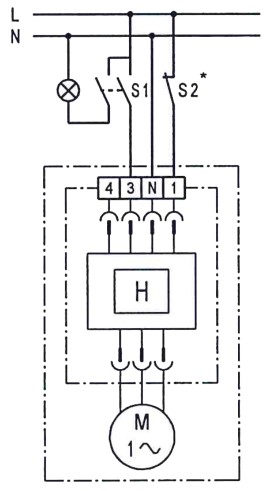
Switching on
The unit is switched manually to full load with switch S1. Humidity control is active.
Switching off
When switching off with S1, the unit continues in full load operation for an overrun time of 15 minutes. If, after this time, the humidity as measured at the unit:
- is higher than the saved reference value, the fan continues to run in full load operation until the humidity drops below the reference value. After the 15 minutes of overrun time, the fan switches back to base load operation.
- is lower than the saved reference value, the fan automatically switches off after an overrun time of 15 minutes.
If switch S1 is open, the unit can start up automatically as a result of high room humidity.
* With switch S2, the unit can also be switched off independently of the room lighting in the event of malfunctions caused by reverse polarity voltages, for example. The humidity function is then inactive.
ER-AP 60 G, ER-APB 60 G
ER-AP 100 G, ER-APB 100 G
G model

The unit with base load function can be run at base load or full load as required.
Switching on
If switch S1 is pressed, the unit runs permanently in base load operation (continuous operation at low speed and low air volume). If the room lighting is also switched on with switch S2, the unit runs at full load (operation at high speed and maximum volumetric flow).
Switching back into base load operation
If the room lighting is switched off with switch S2, the unit switches back into the base load level.
Switching off
The unit can be switched off completely with switch S1. It doesn’t matter what position switch S2 is in